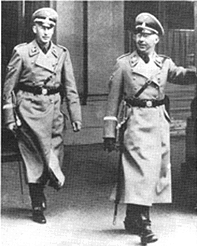The Nazi Police State was to ensure that everybody did as they were told – or paid the price. The Nazi Police were controlled by Heinrich Himmler and his feared secret police – the Gestapo – did as it pleased in Nazi Germany. Children’s loyalty could be developed with a policy of indoctrination via education and the Hitler Youth movement. Time and planning spent in these areas would bring a suitable reward for Hitler.
|
|
Adults were a different proposition. Some adults clearly supported Hitler – as the March 1933 election showed. But the same election clearly showed that a substantial number of Germans did not support Hitler and the Nazis. These people were likely to be a constant thorn for Hitler unless they were dealt with. For these people, the Nazis developed a policy of intimidation. Fear became a by-word for those who did not support Hitler. The wrong comment overheard by a Nazi official could have very serious consequences.
Hitler’s police state worked on the rule that if you said nothing, no harm, could come to you. If you had doubts about the way the country was going, you kept them to yourself – or paid the price. As nearly 17 million people had not voted for either the Nazis or the Nationalist in March 1933, a large and visible police force was required to keep this sizeable group under observation and control.
In Nazi Germany the police were allowed to arrest people on suspicion that they were about to do wrong. This gave the police huge powers. All local police units had to draw up a list of people in their locality who might be suspected of being “Enemies of the State”. This list was given to the Gestapo – the Secret Police. The Gestapo had the power to do as it liked. Its leader – Reinhard Heydrich – was one of the most feared man in Nazi Germany. His immediate chief was Heinrich Himmler. Both men ran their respective branches with ruthless efficiency.
Those arrested by either the police or the Gestapo had less than three minutes to pack clothing and say their goodbyes. Once arrested, they were sent to the nearest police cell. Those in custody were told to sign Form D-11; this was an “Order For Protective Custody”. By signing this, you agreed to go to prison. Those who did not sign it were beaten until they did or officers simply forged their signature. Once a D-11 was signed, you were sent to a concentration camp. How long you stayed here depended on the authorities. The usual rule of thumb was whether it was felt that you had learned your lesson (even if there had not been one to learn) and would behave in an acceptable manner once outside of prison.
The concentration camps were deliberately barbaric. Before 1939, deaths in them occurred but they were not common. The idea was that anybody who had been in one, once released, would ‘advertise’ the fact that they were not places where people wanted to go. This was another way of ensuring that people kept their ideas to themselves.
The concentration camps were run by men who could disguise their violent nature simply because they wore a uniform. The flogging of inmates was common -25 strokes was common practice – and the amenities were very basic and sparse. At Buchenwald, 480 men had one water tap between them which could only be used for 15 minutes on getting up. Any abuse of this rule would lead to 25 lashes. Any arrested Jew would get 60 lashes – a personal order from Hitler. Soap, toothpaste, toothbrushes etc were unheard of in camps such as Buchenwald (which held 8000 prisoners) and Dachau. Food and drink were minimal and the Jews had half the rations of other prisoners
Who would get arrested?
The list was intentionally expansive. Anybody considered to be a political threat was arrested;
those who made jokes about the Nazi Party were also arrested (jokes about Hitler were punished with death); the “work shy” were also arrested (this fitted in exactly with Hitler’s plan to reduce unemployment as an unemployed person would be offered work at a Labour Exchange and if they refused it as too menial for them, they would be arrested as work shy. As no-one in concentration camps counted as unemployed, the figures for unemployment had to come down; “Bibelforscher’s” were also arrested (these were people who would only seek guidance from the Bible and rejected all Nazi ideas and they also refused to do military service); homosexuals were also arrested and the SS used this as a common tactic to discredit someone.habitual criminals were also arrested.
In 1936, the Gestapo Law meant that the activities of the Gestapo were free from any review by courts of law. This law effectively meant that the Gestapo became a law unto themselves. This non-uniformed branch of the SS became justifiably feared just as the visible presence of the black uniformed SS men did. Himmler’s view on the SS was simple. In 1943 he said:
| “We have always selected the highest and abandoned the lowest. As long as we maintain this principle, the Order (the SS) will remain healthy. After the war, we shall really build up our Order……it will provide Germany with an elite. This elite will provide leaders to industry, agriculture and politics and the activities of the mind.” |
![]()
